Table of Contents
Getting customers to adopt your product isn’t just about offering great features—it’s about understanding who your customers are, how they think, and what they need at every stage of the journey.
This guide walks you through the product adoption lifecycle, addressing key topics like:
What is the product adoption process?
Product adoption is when customers start using and ultimately integrate a product into their lives. The new product adoption process is the strategy to help users adopt a product.
It’s worth noting that although the term is widely used in tech and SaaS, product adoption applies across diverse industries, especially when a new product introduces a new behavior or value proposition. Think about reusable bags replacing plastic ones or plant-based products replacing meat.
Product adoption involves activities like:
What are the 5 stages of the product adoption process?
The product adoption process is an indispensable part of the customer journey. All customers—regardless of where they stand in the adoption lifecycle—move through the following stages of the technology adoption process.
Here’s a quick breakdown:
* Some models expand beyond adoption and include six stages in the new product adoption cycle, with the final being loyalty.
👉To learn more about the product adoption process, read our blog post Mastering the new product adoption process: A complete guide for product-led companies.
What is the product adoption lifecycle?
The product adoption lifecycle, also known as the product adoption curve (or technology adoption lifecycle when referring to tech products), is a model based on Everett Rogers’ Diffusion of Innovations theory.
The theory explains how new ideas, technologies, products, or practices (=innovations) are adopted by different groups of people over time (=diffusion). Introduced in 1962, it has become a foundational framework in fields like marketing, communication, public health, and education.
The five stages of the product adoption lifecycle (and how to conquer them all)
Rogers identified five different groups of people that form the five stages of the product adoption curve: innovators, early adopters, early majority, late majority, and laggards. Let’s see the characteristics of adopter categories:
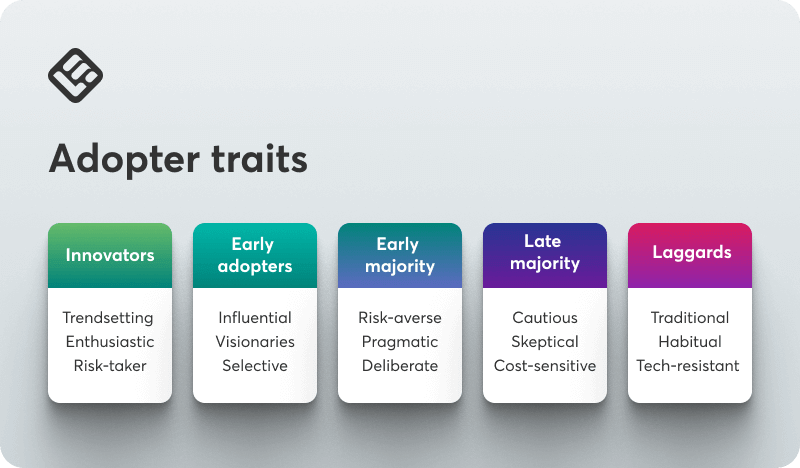
Innovators
What do innovators look like?
In this group, you’ll find tech enthusiasts, risk-takers, and trendsetters. They’re curious and want to try new products before anyone else, even if they are not perfect yet. Only 2.5% of the curve are proud innovators.
How to win them over:
- Give early access or beta versions
- Highlight cutting-edge features and tech breakthroughs
- Offer exclusive trials or invite-only programs
- Encourage them to share feedback and become part of the development process
Early Adopters
What do early adopters look like?
Early adopters are visionaries and opinion leaders. They are big with networking, and their opinion means a lot in their circle. They adopt innovations early but are more selective and cautious than innovators. They are a timid 13.5% of the population.
How to win them over:
- Provide detailed use cases
- Highlight product benefits in your value proposition
- Use influencer marketing or industry thought leaders
- Create community forums where they can share insights
Early Majority
What does the early majority look like?
This group consists of pragmatists who are open to new ideas and willingly follow trends once proven. They’re thoughtful, deliberate, and risk-averse. They account for 34% of the curve.
How to win them over:
- Share customer testimonials, reviews, and case studies
- Emphasize product stability, support, and ROI
- Offer demos, free trials, or onboarding tools
Late Majority
What does the late majority look like?
A demanding target audience to conquer, the late majority are skeptics who adopt out of necessity or peer pressure. They’re conservative, cautious, and cost-sensitive. They wait until the new product is mainstream, affordable, and well-supported. They account for 34% of the population.
How to win them over:
- Simplify onboarding and product knowledge training
- Double down on customer support
- Offer discounts, bundles, or low-risk pricing
- Focus on social proof (“Everyone’s using it”)
Laggards
What do laggards look like?
Laggards are traditionalists who won’t change their ways unless they have to. They’re highly skeptical of innovation, often older or isolated from mainstream trends. They adopt a product only when the old solution no longer exists. 16% of the population falls under this category.
How to win them over:
- Frame adoption as a necessity, not a choice
- Personalize your outreach or use word-of-mouth from trusted contacts
- Make the transition super simple
- Provide personalized and easy-to-follow product training
Crossing the chasm from early adopters to early majority
Overcoming adoption challenges related to the chasm between early adopters and early majority is not easy. Let’s understand what the chasm is, why it’s hard to bridge it, and how you can do so anyway with a careful approach.
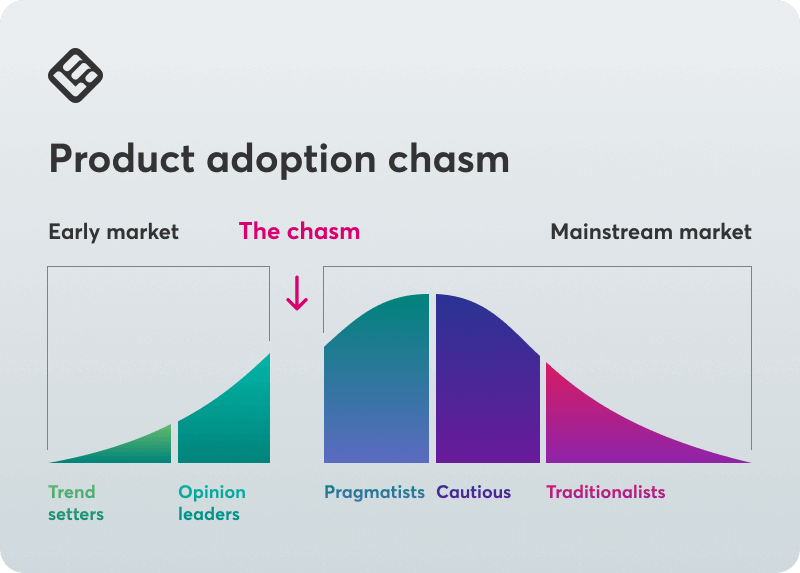
Understanding the chasm concept
Oh, the chasm is real. The term comes from Geoffrey Moore’s book “Crossing the Chasm” and refers to the gap between early adopters and the early majority in the product adoption curve.
On the one hand, you have early adopters who are visionary, willing to take risks, and excited by new possibilities.
On the other, you have the early majority who are pragmatic, risk-averse, and need solid proof before buying in.
Therefore, what appeals to early adopters doesn’t necessarily work for the early majority.
This means that many products get early traction from innovators and early adopters who form only 16% of the population combined but fail to “cross the chasm” and never reach mainstream success.
Challenges in crossing the chasm
Crossing the chasm in the product adoption curve requires profound changes: you need to adjust marketing messages, develop targeted campaigns, and reinforce customer support and onboarding to win over a very different type of customer.
Let’s see why it’s hard to cross the chasm:
Strategies to bridge the chasm
5 factors influencing product adoption
Being familiar with the product adoption curve alone is not enough to bring in and win over new users. Knowing also the factors that impact product adoption will help you improve your marketing messages that resonate with your target audience.
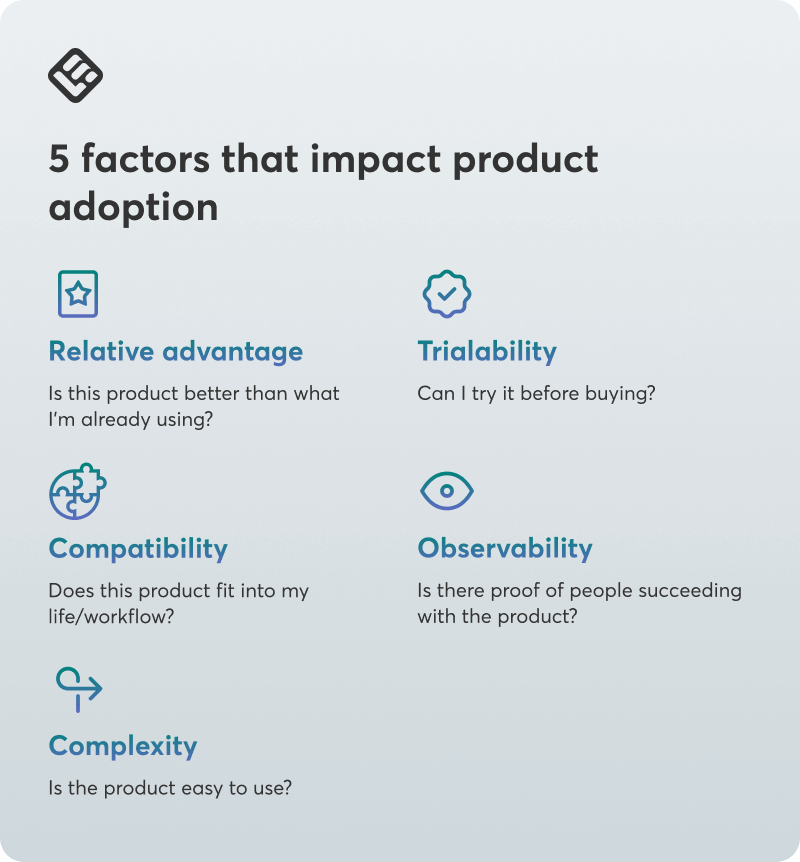
Relative advantage
What it is: How much better the new product is compared to its replacement.
Why it matters: If people don’t see a clear benefit over their current solution, they won’t switch.
Example: Switching from physical maps to Google Maps is a huge improvement in terms of convenience.
Relative advantage has a huge impact on product adoption—more than anything else, according to Nirmal Gyanwali, Founder & CMO of WP Creative:
Nirmal Gyanwali, Founder & CMO, WP Creative
Compatibility
What it is: How well the product fits into a user’s existing values, habits, or infrastructure.
Why it matters: If something clashes with current workflows, beliefs, or tech setups, people resist it.
Example: A plant-based milk brand that’s positioned for eco-conscious consumers aligns with their values—that’s compatibility.
Complexity
What it is: How easy or challenging the product is to understand and use.
Why it matters: If the product is confusing or hard to learn, adoption drops, especially as we move deeper into the product adoption curve.
Example: Software packed with features might be perceived as powerful but also as complex to set up and learn.
Trialability
What it is: How easily potential users can test the product with minimum financial commitment.
Why it matters: People are more likely to try something if they can experiment without commitment.
Example: A free trial of a subscription app lets users explore it before paying.
Observability
What it is: How visible the results and benefits of the product are to others.
Why it matters: If people can see the value, it spreads faster through social proof and word-of-mouth.
Example: Electric cars like Teslas are highly observable—you notice them on the road, in conversations, and media.
Examples of successful product adoption
Zoom and Oatly are two very different but also very successful brands—a tech and a non-tech product that have managed to gain loyal customers and become prominent names in their markets.
Let’s see how they did it.
Zoom
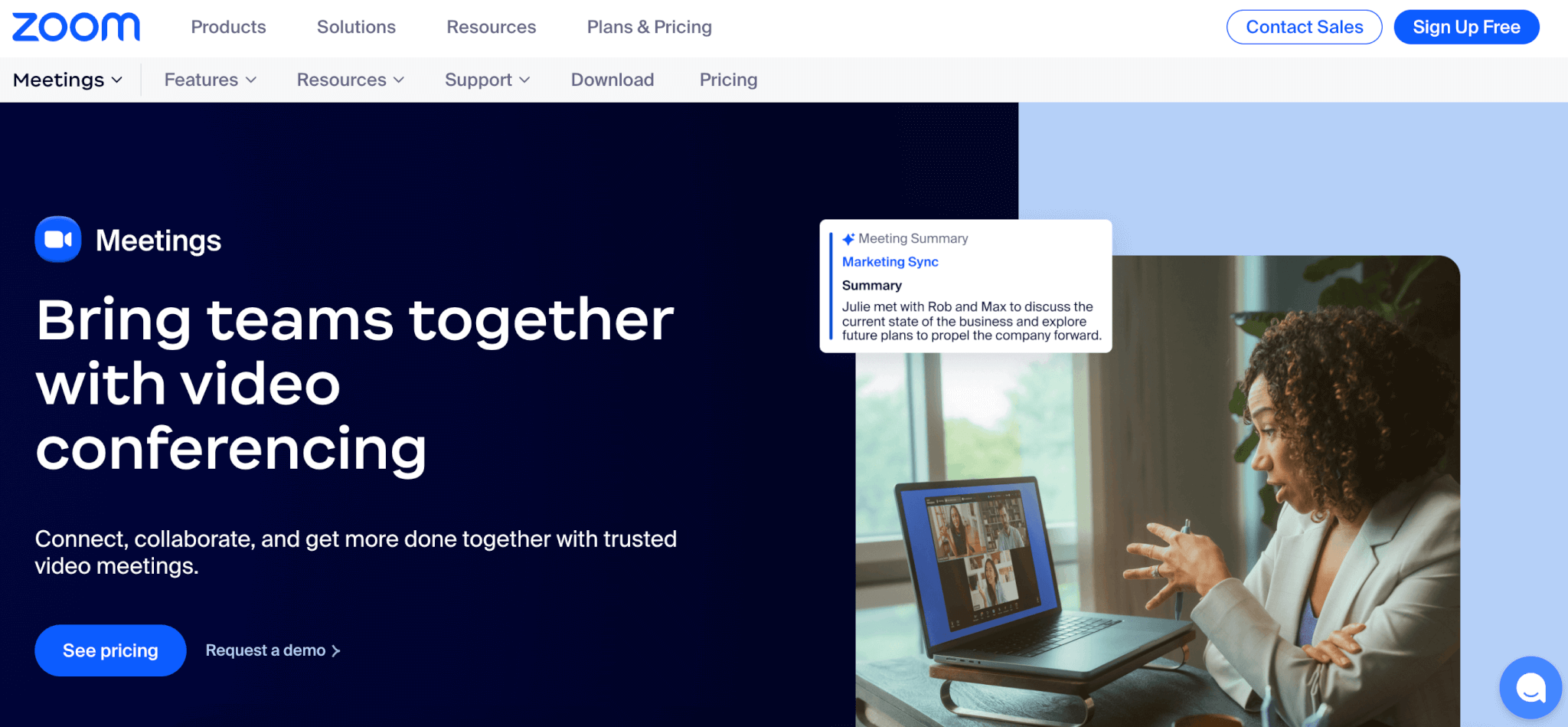
Zoom was founded by Eric Yuan in 2011, a former executive at WebEx. Yuan felt the existing video conferencing tools were too complex and unreliable, so he wanted to create a better alternative.
How did Zoom dominate the video conferencing market?
💡 How did Zoom address each product adoption factor?
Oatly
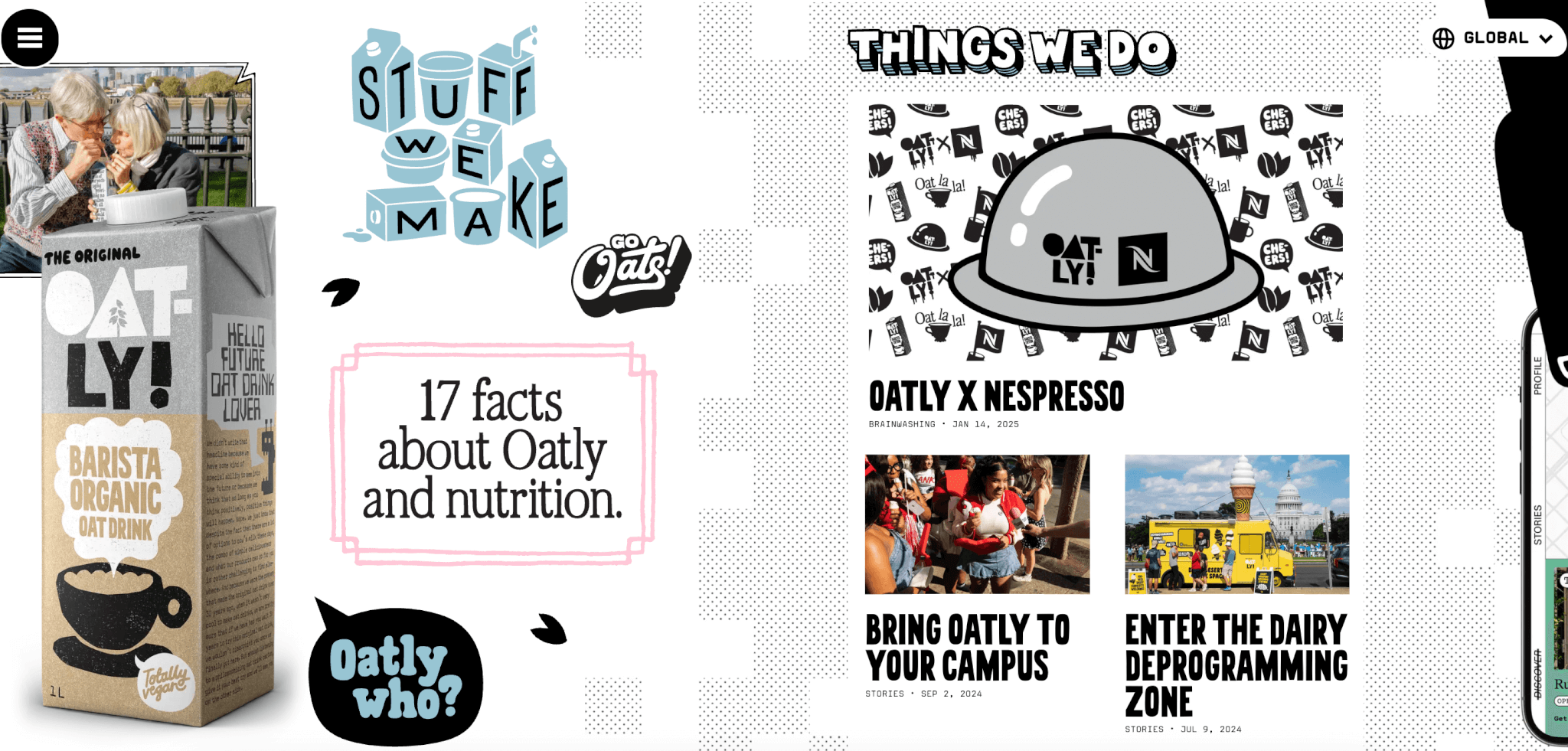
Oatly, founded in the 1990s in Sweden, has reinvented how plant-based milk could be marketed and adopted globally. With quirky branding, smart positioning, and cultural relevance, it became a household name.
How did Oatly break into a dairy-dominated market?
💡 How did Oatly address each product adoption factor?
10 strategies to enhance product adoption
Boosting product adoption across all customer segments doesn’t happen by chance. It’s a mix of design, communication, support, and iteration. Here are ten proven strategies to help guide users from the first interaction to loyalty:
8 product adoption metrics to track
Product adoption metrics
How to use customer education for higher product adoption
Customer education plays a tremendous role in boosting product adoption. Here’s a quick breakdown of why it matters and how to do it effectively:
What is customer education?
Customer education is the process of equipping users with the knowledge and skills they need to understand, use, and succeed with your product. Customer education involves different initiatives and is present throughout the customer journey (yes, even from the awareness phase).
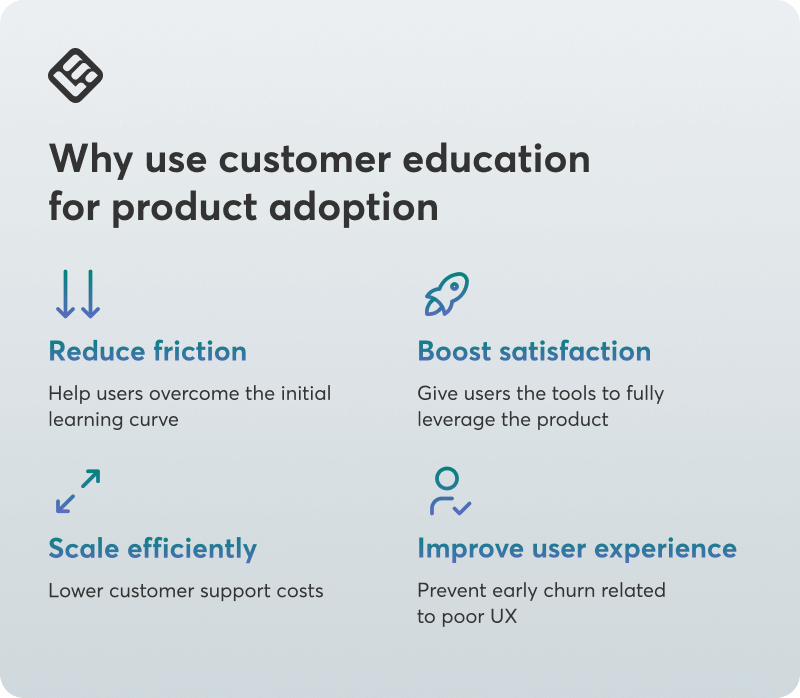
Customer education tactics that work
💁Download our free ebook to learn how to build customer education courses from start to finish.
Ready to master the product adoption lifecycle?
Product adoption is a milestone in the customer’s post-purchase journey. It’s worth investing time and money to not only attract new customers but also give all users the tools to learn your product and make it part of their lives.
Customer education plays a pivotal role in engaging the most reluctant segments of the product adoption curve and achieving mainstream adoption. Use a customer education platform like LearnWorlds to centralize your training resources, offer on-demand access to learning material, and host live sessions, all from one platform.
Explore LearnWorls now with a 30-day free trial.

Androniki Koumadoraki
Androniki is a Content Writer at LearnWorlds sharing Instructional Design and marketing tips. With solid experience in B2B writing and technical translation, she is passionate about learning and spreading knowledge. She is also an aspiring yogi, a book nerd, and a talented transponster.

